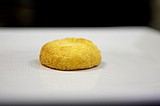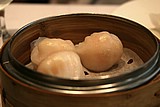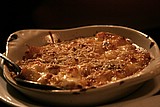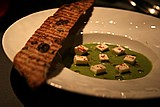Home |
Restaurants by City
|
Food Photography |
Archive | Philosophy |
![]()
Right now we are eating in Seattle, Washington.
|
Friday
2005
Permalink
|
Passover Coconut Cookies from Lampreia, tasted on March 13, 2005 — For as long as I can remember macaroons have been a fixture of every Passover in my life. I didn’t even used to really like coconut, but year after year, when faced with the narrow selection of kosher for Passover foods available at the supermarket, macaroons invariably make their way into my shopping cart. Some years I get chocolate as well as the traditional plain just to spice things up. And some years they actually taste semi-fresh coming from their sealed cylindrical cardboard containers. Macaroons not only serve as part of dessert during Passover meals, but also as between-meal snacks. You might imagine that matza could serve that purpose, but usually people get matza’d out relatively quickly, so the trusty Macaroon comes to the rescue. Unfortunately, even the best packaged variety can be a little heavy and dry. Put Passover aside for a second and now consider going out to dinner during the rest of the year. In fact, go out to dinner at a higher end restaurant. Often at the end of the meal you may get a small plate with an assortment of mini-cookies and chocolates – “petit fours”. According to the Oxford Companion to Food, the little ovens in which these post-meal small “cakes” were baked may be the origin of the name. Etymology aside, it’s on the petit fours dish at one of Seattle’s few world class restaurants that I discovered the object of the macaroon quest I didn’t even know I was on. For 12 years in Seattle’s Belltown neighborhood, Chef Scott Carsberg of Lampreia Restaurant has quietly and diligently perfected his refined expressions of Northern Italian food. This is Italian food quite unlike what most American’s would recognize. Odds are many of the diners think the food is French. In fact much of the culinary “spine” of the cuisine hails from the Alto Adige region of Italy that borders with Austria and Switzerland. Chef Carsberg’s cooking uses this framework to ground his cooking, but innovates freely within the framework, using seasonal local ingredients, a genius for flavor and texture combinations, and a near obsessive focus on flavor and quality. Who else would spend so much time making a simple macaroon? But Chef Carsberg’s macaroon isn’t strictly a macaroon. Technically, it’s more of a haystack. A coconut macaroon (they’re often made from almonds as well) is related to the meringue family as it relies on separated egg whites as a key component. A haystack doesn’t have the almond “roots” or the egg whites and as best I can tell, it’s often cooked mostly or even entirely on the stove, not baked in the oven. The batter is dropped in a little haystack-like pile on a cooking sheet, allowed to cool, and then is ready to be eaten. Chef Carsberg’s cookies are cooked both on the stove and in the oven. And regardless of what genus they belong to, Carsberg decided that his shouldn’t have any flour. He was focused on having his cookies be singular examples of deep buttery coconut goodness, with a light chewiness that you simply won’t find in any other coconut cookie you’ve ever eaten. Lucky for us, his singular focus on flavor and texture also made his cookies kosher for Passover. Before we embark on making the actual cookies, a couple of notes: 1) The recipe is dairy. The reason the cookie is so good is that it tastes like an entire stick of butter has been condensed into each one. You don’t get that buttery flavor without… well… butter. Don’t even think of using margarine. 2) The recipe yields a lot of cookies. You want the cookies to be relatively small, and depending on just how small you will get several dozen cookies. That said, Passover is eight days, and these cookies are delicious.
Lampreia Coconut Cookies by Chef Scott Carsberg
Crack the eggs into a bowl large enough for aggressive whisking and whisk with gusto. Chef Carsberg says you cannot overwhisk eggs. They need to be truly integrated to give the most consistent possible texture. Whisk until it hurts. In a deep saucepan (large enough to hold all the ingredients and leave room for whisking) melt the butter over a medium flame. Do not let the butter get over 186 degrees or it won’t emulsify later. With a separate whisk stir the butter repeatedly as it melts so it doesn’t separate. Remove the saucepan from the flame while there are still some solid chunks of butter in the mixture, but they’re small enough to melt even off the flame with the help of a whisk. With the butter melted but not separated slowly pour the sugar mixture into the saucepan with the butter whisking all the while. Mix aggressively so that the sugar is truly integrated into the butter. At first the melted butter will creep up the side of the saucepan during mixing and look relatively thin. The sugar is integrated once the mixture up the side looks thicker. Let the mixture sit for a couple of minutes to cool down while the eggs are re-whisked. You need to mix the beaten eggs into the butter and sugar but can’t do it until the butter-sugar mixture is below 100 degrees or you will get sweet buttery scrambled eggs. Once the mixture has cooled down, and the eggs have no inconsistencies slowly pour the egg mixture into the butter and sugar mixture in the saucepan, whisking energetically while the egg is slowly poured in. Once the ingredients are completely integrated, put the saucepan back on a medium flame and repeat the procedure pouring the Fine Macaroon Coconut into the saucepan, and whisking. The goal is now to mix the coconut completely with the rest of the batter, and slowly cook the mixture until it naturally pulls away from the sides. At first the batter should still be relatively wet. Cook the mixture for 5-10 minutes over low-medium flame mixing well with a wooden spoon the entire time. The goal is to slowly eliminate some of the moistness while not letting any of the batter get brown. Liberal and consistent mixing with the spoon should achieve the desired effect. When the batter would rather stick to itself than to the side of the saucepan, take the batter off of the flame. Let the batter sit on the counter in the saucepan for another hour, mixing every 10 minutes with the wooden spoon. Then seal the batter in an air-tight container and let it sit overnight in the refrigerator. The next day you should have a dough that can be made into tablespoon size balls with out any compression from your hands. The less you rely on your palms, and the more you rely on your fingertips, the lighter your cookies will be. Place the cookies on a non-stick baking sheet and bake in the oven for 10-20 minutes at 350 degrees. The key is to watch them very closely. The will get a golden color but shouldn’t get much darker than that. Baking time will vary depending on the quirks of your oven as well as the size of the cookies you made. When they’re done, remove them from the oven, allow them to cool for awhile on the baking sheet, and then on a plate. You should now have several dozen cookies ready to either cap off a world class meal at a fine restaurant or satisfy your family’s cravings between meals. Either way, they’re delicious. Note: These beautiful pictures were taken by Peyman. Also, this post is rebroadcast from its original appearance in the JTNews.
|
|||
Our Sponsors
Free Car Listings – Hot Tubs – Stools – Saunas – Bar Stools - Calendar and Event Schedules - Food Events and Calendars - Wine Events and Calendars - Digital Photography Resources - Software for Advertisers - Jewish Gifts and Judaica - Howard Stern Podcast - ponytailed blogger Jonathan Schwartz

Browse tastingmenu
Home |
Restaurants by City X |
Food Photography |
Archive | Philosophy |
![]()
Free eBooks: All About Apples
| Autumn Omakase
More:
Discussion |
Cool Food T-Shirts |
Ingredients
| Markets |
Recipes
Search |
Blog FAQ |
Other
Blogs
Best of tastingmenu
|
City View
Entry: July 6, 2006 |
Blue Plate
Entry: June 19, 2006 |
L'Atelier de Joël Robuchon
Entry: July 18, 2006 |
Browse by City
Boston | Chicago | Houston | Las Vegas | Los Angeles | Maui | New York | Philadelphia | Portland | San Francisco | Seattle | Toronto | Utah | Vancouver | Washington D.C.
Bangkok | Beijing | Hong Kong | Seoul | Tokyo
Amsterdam | Berlin | Italy | London | Madrid | Paris | Vienna
Browse by Month
2006
2005
2004
2003
2002
2001
Comments, questions, or feedback:
info / at / tastingmenu / dot / com
All pages Copyright (c) 2001-2006 tastingmenu.com
Last modified 01/30/07.




